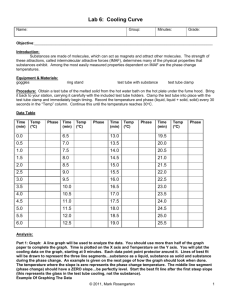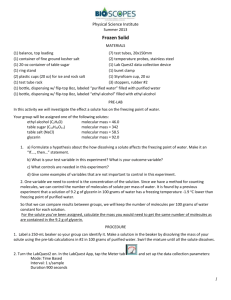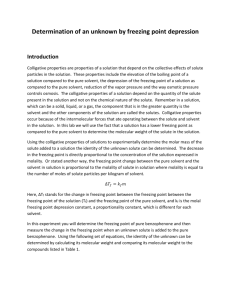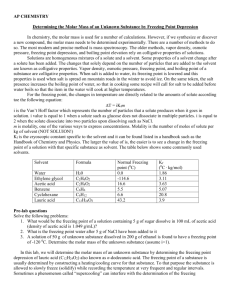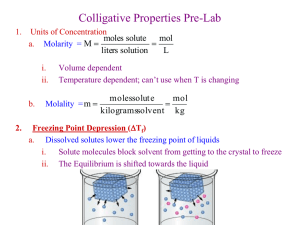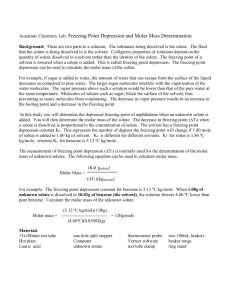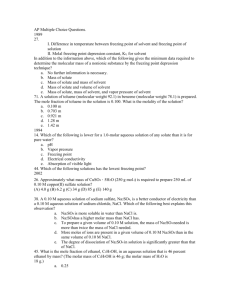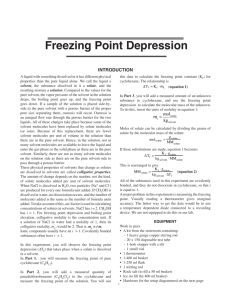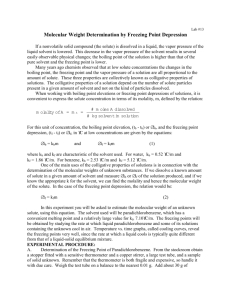Chapter 12: Physical Properties of Solutions - NP
advertisement
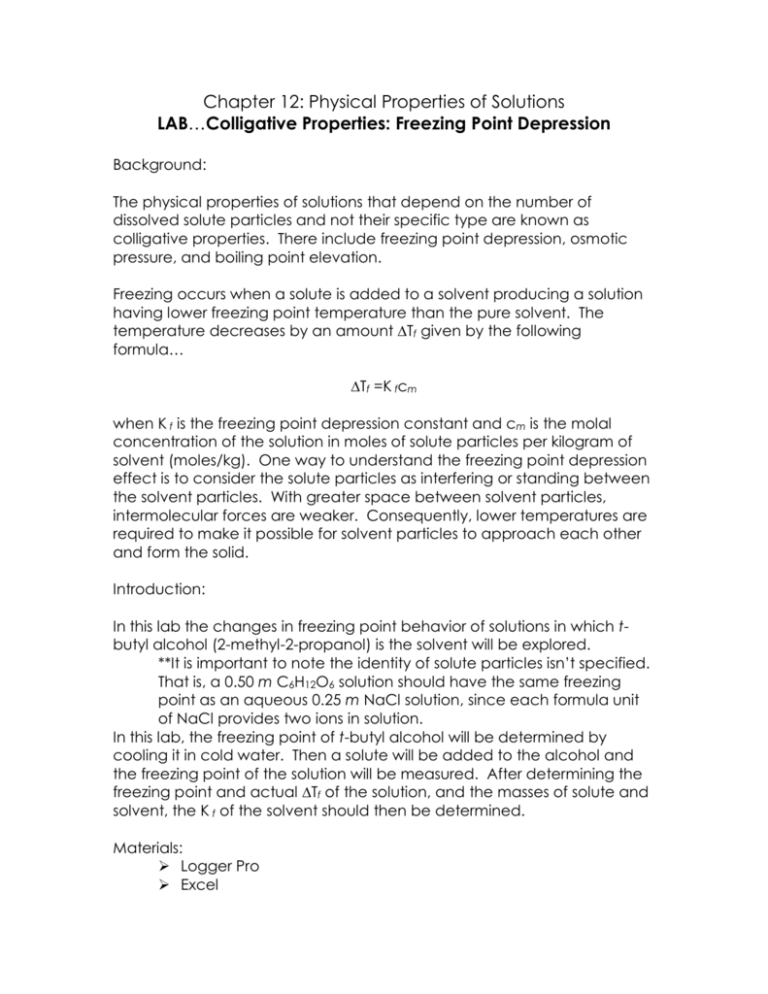
Chapter 12: Physical Properties of Solutions LAB…Colligative Properties: Freezing Point Depression Background: The physical properties of solutions that depend on the number of dissolved solute particles and not their specific type are known as colligative properties. There include freezing point depression, osmotic pressure, and boiling point elevation. Freezing occurs when a solute is added to a solvent producing a solution having lower freezing point temperature than the pure solvent. The temperature decreases by an amount Tf given by the following formula… Tf =K fcm when K f is the freezing point depression constant and cm is the molal concentration of the solution in moles of solute particles per kilogram of solvent (moles/kg). One way to understand the freezing point depression effect is to consider the solute particles as interfering or standing between the solvent particles. With greater space between solvent particles, intermolecular forces are weaker. Consequently, lower temperatures are required to make it possible for solvent particles to approach each other and form the solid. Introduction: In this lab the changes in freezing point behavior of solutions in which tbutyl alcohol (2-methyl-2-propanol) is the solvent will be explored. **It is important to note the identity of solute particles isn’t specified. That is, a 0.50 m C6H12O6 solution should have the same freezing point as an aqueous 0.25 m NaCl solution, since each formula unit of NaCl provides two ions in solution. In this lab, the freezing point of t-butyl alcohol will be determined by cooling it in cold water. Then a solute will be added to the alcohol and the freezing point of the solution will be measured. After determining the freezing point and actual Tf of the solution, and the masses of solute and solvent, the K f of the solvent should then be determined. Materials: Logger Pro Excel Temperature Probe Large Test Tube 25mL graduated cylinder T-butyl Alcohol Scale 2: 400mL beakers Ice Hot Place Ring Stand and Clamp 2: Copper Stirrers Procedures: 1. Connect a temperature to LabPro interface and launch Logger Pro and Excel applications on computer. Set Logger Pro to “Time Based” mode with an experiment length of 10 minutes and a sampling rate of 10 samples/minute 2. Measure and record the mass of a clean, dry large test tube (**it is extremely important the test tube is clean and dry!!) 3. Using a graduate cylinder, pour 20 mL of t-butyl alcohol into the test tube and measure the new mass. Using basic arithmetic, find the mass of the t-butyl alcohol. Record data in excel spread sheet or lab notebook. 4. Prepare an ice water bath in a 400-mL beaker. Prepare hot water bath in a 400-mL beaker using a hot plate (temperature should be 40-50C). 5. Clamp test tube to ring stand and insert a clean, dry copper stirrer into the test tube and clamp temperature probe into the test tube. (**make sure that the probe does not touch the walls of the test tube and yet is still well-immersed in the liquid and copper stirrer should surround the probe). 6. When you are ready to begin data collection click on the “start” button and quickly lower the test tube into the cold water bath. Continuously stir the test tube inside the beaker in an up/down motion. (**make sure the probe stays in the water and does not hit the wall of the test tube). Continue stirring and collecting data until temperature levels off. Once a constant temeperature is obtained remove the test tube from the ice bath and place it in the hot water bath. This with then thaw the solid. 7. Save data collected. 8. Repeat steps 4-6, so multiple trials of data may be collected. 9. After two trials remove test tube from the clamp and dry thoroughly. Next, record the mass of the test tube and contents and calculate the mass of remaining t-butyl alcohol by using the mass if the test tube recorded previously. 10. Dispose of the solution in waste beaker and clean all equipment. Calculations and Questions: 1. Calculate the molality for each trial of the solutions. 2. Calculate the freezing point depression for each trial of the solutions. 3. Using the molality and freezing point depressions, calculate the freezing point depression constant for teach trial of solutions. 4. Find the average value for the Kf. 5. Assuming the values obtained for the freezing point and Kf of t-butyl alcohol are correct, find the molecular weight of the substance that yielded a freezing point of 18.2C when 1.06 g of the substance was dissolved in 18.36 g of t-butyl alcohol. 6. Melting point temperatures are frequently used to help identify unknown solids and determine their purity. How would the melting point of a pure solid sample compared to that of the same solid contaminated by a solid impurity? Explain.

